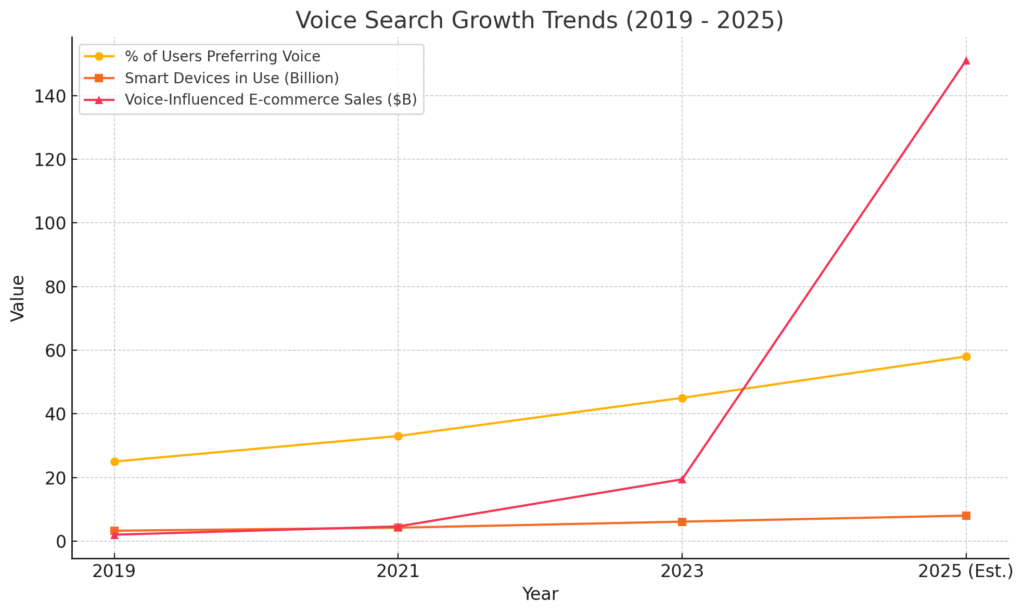Voice search for eCommerce is changing the way people shop. It is no longer just a tech trend. It has become a part of everyday behavior. People now talk to their devices just like they ask a friend for advice or product suggestions.
Voice search for eCommerce is no longer optional. It has become a powerful way consumers interact with brands online. As smart assistants like Alexa, Siri, and Google Assistant become part of daily life, shoppers are changing how they search, discover, and buy products.
This shift goes beyond convenience. It’s about creating faster, more intuitive shopping experiences. To stay ahead, your brand must be ready to speak your customers’ language.
Voice search technology is advancing rapidly, and so is the user adoption rate. As this feature becomes more embedded into everyday routines, businesses that adapt their strategies accordingly are positioned to capture attention, trust, and revenue.
If your eCommerce brand is not ready for this shift, you are already behind how modern consumers prefer to shop.
Voice Search Growth Year-on-Year
Voice commerce is seeing rapid adoption with smart devices becoming part of daily life. According to Kinsta, the global voice commerce market is expected to grow significantly in the coming years, driven by AI integration and hands-free convenience.

| Year | % of Users Preferring Voice | Smart Devices in Use (Billion) | Voice-Influenced E-commerce Sales ($B) |
| 2019 | 25 | 3.25 | 2 |
| 2021 | 33 | 4.2 | 4.6 |
| 2023 | 45 | 6.1 | 19.4 |
| 2025 (Est.) | 58 | 8 | 15 |
Voice Search for eCommerce Examples
Voice commerce is feels like magic. You ask, and you get an answer.
People now say things like “Alexa, reorder my monthly groceries” or “Hey Google, are these shoes in stock?”
They are speaking more and typing less. This is changing how search results are delivered.
Voice search ecommerce is more conversational and come with clear intent. Users want fast, relevant responses. Your content must be prepared to meet that need in a natural tone and structure.
Let’s look at real-world scenarios:
- A user says, “Hey Google, best wireless earbuds under 3000,” and gets a featured snippet with a product suggestion.
- Someone tells Alexa, “Order face wash for oily skin,” and Alexa selects a recommended listing from Amazon.
- A customer says, “Find me a dry fruits shop open near me,” and gets a Google Business listing with directions.
- An iPhone user says, “Hey Siri, where can I get vegan snacks nearby?” and receives a list of top-rated nearby stores.
Right ways to optimized Your brand So you can be the answer
Your brand can be the answer if the content is optimized the right way. Voice assistants prioritize content that’s clear, conversational, and structured to match natural speech patterns. With proper voice search optimization, your products or services can surface at the exact moment users ask for them—turning intent into action.
Optimizing for Siri: Apple’s Voice Assistant
Siri, Apple’s voice assistant, plays a crucial role in how users interact with eCommerce platforms via iPhones, iPads, and other Apple devices. To optimize for Siri:
- Ensure your business is listed on Apple Maps and linked to your Apple Business Connect profile.
- Use conversational keywords and natural phrasing in your site content and FAQs.
- Focus on local SEO and short, actionable answers that Siri can pick and speak aloud.
Since Siri uses data from Apple Maps, Yelp, and Safari browser queries, ensuring accurate listings and content there can help your business surface during Siri searches.
Alexa SEO: Boosting E-commerce Visibility with Smart Assistant Integration
If you sell on Amazon, Alexa should be part of your SEO strategy. Alexa pulls product data from the Amazon marketplace, not traditional web pages.
- Use long-tail keywords: Customers speak in full sentences. Instead of “headphones,” they’ll say “What are the best wireless headphones for workouts?”
- Structure your listings with bullet points: Well-formatted descriptions are easier for Alexa to read aloud. Use clear, voice-friendly bullets that highlight benefits.
- Add product reviews and ratings: Alexa uses reviews to gauge credibility. Listings with more positive feedback are more likely to be recommended.
By making your Amazon listings voice-ready, you give Alexa what it needs to promote your products.
Optimize E-commerce Stores for Google Assistant Voice Queries
Google Assistant pulls data from your website, not from Amazon. Your site content needs to be optimized for how people speak, not just how they type.
- Use schema markup: Structured data helps Google understand your content and show it in voice results.
- Write in a conversational tone: People say “Where can I buy almonds near me?” instead of “almonds shop near me” Your content should mirror natural speech.
- Create and optimize your Google Business Profile: If you have a physical store, this helps you appear in local voice search results like “best dry fruits shop open now.”
Once your foundation is built, it’s time to focus on how your content sounds.
Voice Content Strategy for e-commerce that works
Content that speaks like a human builds trust and increases voice visibility. Now, let’s talk about the tech side.
1. Crafting Conversational Copy That Converts
Voice content needs to sound human. Robotic or keyword-heavy language will not work here. Natural and conversational tone works here to drive result or features in voice search.
- Avoid keyword stuffing: Instead of “buy skin cream SPF 50,” write “Looking for a sunscreen that’s light and protects well in summer?”
- Use real-world questions: Create content around queries like “How do I pick the right yoga mat?” or “What’s the best face cream for dry skin?”
- Use question-style headings and full-sentence answers: Voice assistants pull short, clear answers. Keep it helpful, natural, and relevant.
2. Website Optimization: Tips for Voice Search Success
Even the best content won’t perform if your website isn’t fast or mobile-friendly.
- Optimize page speed: Slow pages kill voice search potential. Use compressed images, remove unnecessary scripts, and use reliable hosting.
- Improve mobile user experience: Since most voice searches come from smartphones, your website should be touch-friendly, easy to read, and smooth to navigate.
- Implement schema.org markup: Structured data makes your content easy for voice assistants to find and speak aloud.
3. FAQ Content for Voice Commerce: Don’t Just Sell, Solve
Voice search for ecommerce is full of questions. Your FAQ section should be ready with answers.
- Use real voice-style questions: Examples: “How do I return a product?” or “What should I wear for a wedding dinner?”
- Keep answers short and to the point: Voice assistants prefer 20 to 30 second replies. Long answers may be skipped or not read fully.
- Organize questions by topic: Group them under categories like shipping, returns, size guide, and care instructions. This helps both users and voice tools find relevant answers.
Once your content is up and running, it’s time to measure its performance.
4. Analytics and Tracking for Voice Search Optimization
To improve anything, you need to track it. Voice search is no different.
- Monitor voice-style keywords: Use Google Search Console to identify long-tail and conversational phrases like “best snacks for toddlers” or “energy-efficient geyser under 10k.”
- Test different FAQs and descriptions: Try two styles of the same product description. See which one gets more visibility and engagement.
- Track which pages are picked up for voice results: This will show what works and what needs better optimization.
After reviewing performance, keep an eye on what’s coming next in voice search for ecommerce.
Emerging Voice Search Trends to Watch in 2025 and Beyond
Voice search is evolving fast and changing how we shop.
- AI-powered personalization: Voice assistants are getting better at understanding user preferences and delivering custom suggestions.
- Multi-language voice support: Brands that offer content in more languages will connect with a broader audience.
- Smart device and IoT integration: Customers may soon shop using voice from their refrigerator or smartwatch. Your content should be ready to support these touchpoints.
Being early to adapt gives your brand an edge. Voice Search for Ecommerce or we can say Voice commerce is no longer futuristic. It’s here and growing fast.
Final Thoughts: Talk Is Cheap, but Voice Search Isn’t
Ignoring voice search for ecommerce today is like ignoring mobile in 2010. We know how that ended.
Voice search for ecommerce is now a customer expectation. Brands that optimize for Alexa and Google Assistant, write for natural speech, and build fast, mobile-friendly websites will lead this shift.
Start now and partner with teams like Growwithba to analyze your competitors and build a voice-ready digital presence that grows with the market.
FAQs On Voice Search Optimization
1. What Is Voice Search Optimization?
Voice search optimization is the process of preparing your website and content to appear in voice-based search results. It involves understanding how people speak when searching, using conversational keywords, implementing structured data, and ensuring mobile and site speed performance meet high standards.
This optimization ensures that your brand’s answers are the ones smart assistants like Siri, Alexa, and Google Assistant read out loud. It makes your business more accessible and visible in a world where customers prefer speaking over typing.
2. What Is Voice Search Marketing?
Voice search marketing focuses on reaching users through voice-enabled platforms. It includes optimizing content for voice queries, running local search campaigns, and tailoring SEO strategies for smart assistants.
When done right, voice search marketing makes your brand discoverable during voice interactions. This is crucial when users are multitasking or making quick decisions on the go.
3. Why Voice Search Is Booming in eCommerce
Voice-based eCommerce is growing fast. More than half of online consumers now use voice search regularly. With hands-free devices and wearables, users are browsing, comparing, and shopping using natural speech.
Whether it’s finding local products, reordering daily items, or looking for top-rated recommendations, voice search plays a major role in each stage of the buyer journey.
4. What is the future of voice search optimization?
It is AI-driven, more intuitive, and deeply woven into everyday life. Voice commerce will become smarter and more context-aware.
5. How do you optimize for voice search for ecommerce?
Use natural language, conversational keywords, fast-loading mobile sites, and structured data markup.
6. What is a best practice for voice SEO?
Include question-based content, schema.org markup, and answer phrases people are likely to say aloud.
7. How can e-commerce specialists improve their voice search strategy?
Optimize for mobile, simplify navigation, use conversational product descriptions, and track performance regularly.
8. What’s the biggest benefit of using voice-focused search campaigns?
They help increase product discovery, drive more qualified leads, and make shopping easier and faster for users.
![BA LOGO 2[1] Logo](https://growwithba.com/wp-content/uploads/elementor/thumbs/BA-LOGO-21-rctdwc6e44k0gscol760abdhmupxvrcikanaiw5kow.png)



